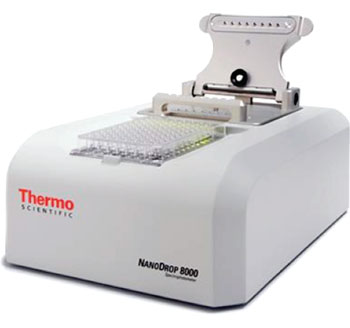DNA Alterations Identified Occur Earliest in Lung Cancer Development
By LabMedica International staff writers
Posted on 01 Oct 2015
Lungs resected for adenocarcinomas often harbor minute discrete foci of cytologically atypical pneumocyte proliferations designated as atypical adenomatous hyperplasia (AAH), which may represent an initial step in the progression to adenocarcinoma in situ (AIS).Posted on 01 Oct 2015
DNA alterations in the tissue and blood of people with precancerous and cancerous lung lesions has been identified in what it believes are among the very earliest "premalignant" genetic changes that mark the potential onset of the most common and deadliest form of disease.

Image: The NanoDrop 8000 UV-Vis Spectrophotometer (Photo courtesy of Thermo Scientific).
Scientists at Johns Hopkins University School of Medicine (Baltimore, MD, USA) collected retrospectively formalin-fixed, paraffin-embedded (FFPE) lung cancer specimens harboring multiple AAH lesions and AIS or minimally invasive adenocarcinoma (MIA) tumors. DNA was extracted from 25 distinct AAHs incidentally discovered in the lung resection specimens from six patients with invasive adenocarcinoma. Samples from AIS and MIA tumors extracted from five patients each were collected from different zones of histologic progression within the same lesion. Three or four histologically different zones were collected from each AIS and MIA samples respectively.
DNA was extracted using standard protocols and quantified with the Nanodrop system (Thermo Scientific; Wilmington, DE, USA). The CancerSelect-R panel was used to analyze the regions of 125 well-characterized cancer genes to identify tumor-specific (somatic) mutations, copy number changes and translocations. Paired-end sequencing, resulting in 150 bases from each end of the fragments, was performed using a MiSeq System (Illumina; San Diego, CA, USA). All droplet digital polymerase chain reactions (ddPCR) assays used in the study were designed and optimized to work in the ddPCR system by Bio-Rad (Hercules, CA, USA).
The team found that V-Ki-ras2 Kirsten rat sarcoma viral oncogene homolog (KRAS), tumor protein p53 (TP53) and epidermal growth factor receptor (EGFR) mutations are indicators of malignant transition. Utilizing droplet digital PCR, they found alterations associated with early neoplasms in paired circulating DNA. When the team further explored different regions within the same lesion, they found genetic differences even within the same lesion. Mutations associated with good and poor prognosis or responses to therapy were seen in different regions of the same tumor, highlighting the limitations of single biopsies commonly used to decide patients' therapies.
David Sidransky, MD, a professor of oncology and pathology and senior author of the study said, “This study takes detection to a whole new level in terms of size of the lesion. I'm not aware that circulating DNA from precancerous lesions this small has ever been identified before.” As they detected the mutations in the fluids, even mutations found in only one specific zone of a lesion, Prof. Sidransky added, “That this finding may indicate that a blood or sputum test could better represent the overall composition of a tumor than a single biopsy sample.” The study was published on September 16, 2015, in the journal Nature Communications.
Related Links:
Johns Hopkins University School of Medicine
Nanodrop
Illumina














